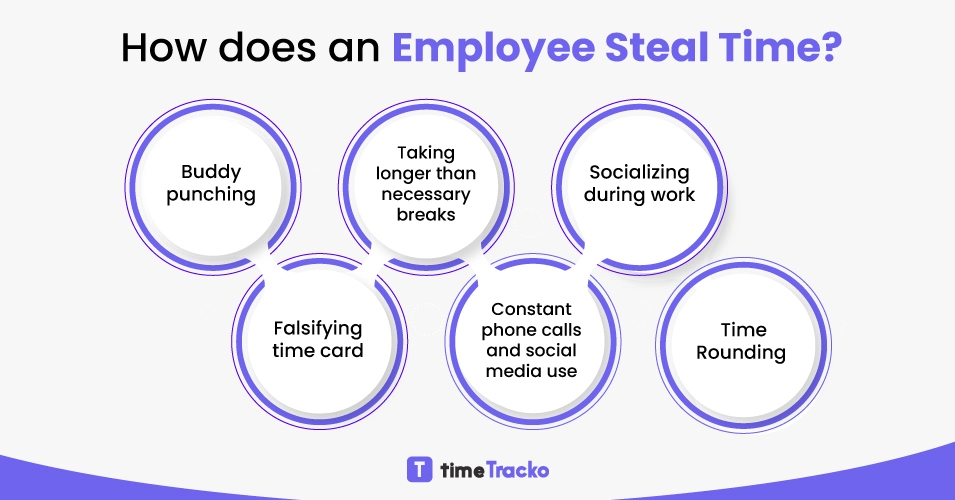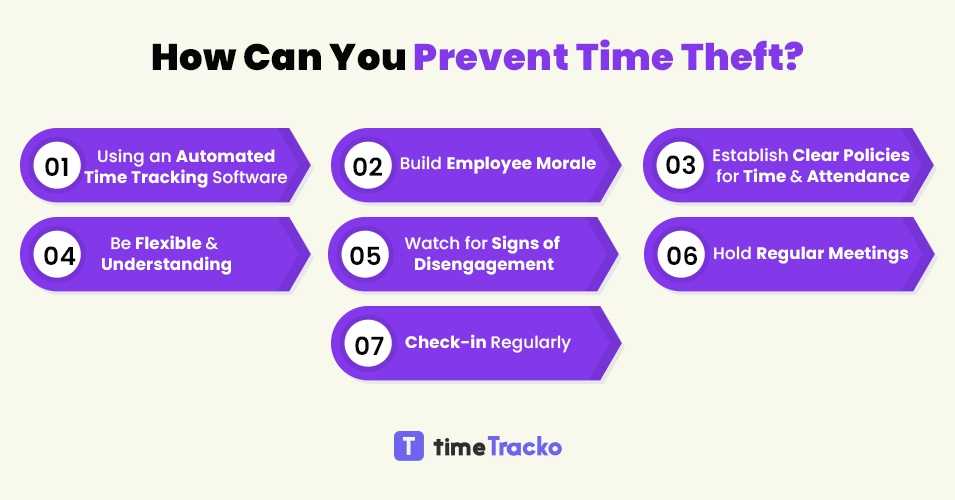7 Best Ways To Prevent Time Theft at the Workplace. The Ultimate Guide
7 Best Ways To Prevent Time Theft at the Workplace. The Ultimate Guide
“Time theft can hurt productivity so much that low productivity and performance becomes your new normal.”
Your concern as a manager might be how to manage employee working hours more effectively. Researchers estimate that 30 % of businesses suffer from employee-time theft.

Time theft is a serious issue that is caused when employees manipulate the system and get paid for the work they haven’t done. There are different ways for employees to steal time, but the result is the same – the employees claim wages without actually working.
Procrastination, low productivity, inefficient tracking, and time theft are serious issues that need immediate concern in today’s businesses. Don’t ignore them, or you’ll find that your business suffers.
Businesses are dealing with a growing epidemic of time theft. Many modern companies face the problem of time stealing, especially those that have many remote workers who work from home without supervision.
As per the American Society of Employers, about 20 percent of dollars earned by the U.S. company has vanished in employee time theft. This has led to a productivity loss of $400 billion yearly.
Analysis of employee time theft shows:
- About 25% of businesses have experienced over $1 million in losses due to employee theft.
- The manager was responsible for 37.1 % of all thefts.
- In retail, one in three employees was arrested for internal time theft.
- Study shows that employees steal nearly 6 hours a week from their employer, resulting in businesses losing millions of dollars every year.
This article addresses the best ways to prevent time theft in the workplace. Read the article till the end to know more about it.
What is Time Theft at Work?
The concept of time theft at work is the use of time for unproductive activities and getting paid for work they did not perform.
Software advice research indicates that 43% of hourly workers underestimated the amount of time they worked during shifts.
Theft of employee time can take many forms, which is why it is very difficult to detect. This may occur in many different ways: long breaks, late starts, early finishes, personal activities on the job, rounding timesheets, etc.
There are a lot of time thieves who are creative in how they avoid tasks, and with today’s mobile workforce, it is certainly becoming more prevalent. It has been difficult for employers to identify and stop time fraud.
Time theft can harm productivity so badly. Your entire team suffers from decreased productivity; someone else makes the same amount of money while doing less work and producing fewer results demotivates hard-working employees.
Must Read: Looking for productivity tips to succeed at work?
How Does an Employee Steal Time?
Businesses suffer from a large amount of time theft.
Time theft is the unsanctioned use of time while on the job. More specifically, it’s time for which employees get paid that was not spent on tasks.

Employees steal time in various ways, including:
1. Buddy Punching
An employee clocking in and clocking out for their coworker represents buddy punching.
For example,” An employee might ask a trusted colleague to punch in for their work if they are running late.” This refers to buddy punching. In contrast, a time-theft incident takes place when an employee does not arrive at work for another 20 minutes after clocking in.
They can still be paid for their shift even if they are absent. As a result, the system believes the employee has worked a full day when they have not.
A study in 2018 estimates that over 370$ million annually was wasted on payroll due to buddy punching. Also, companies lose 5% of their annual income due to buddy punching.
What Is The Reason Behind Buddy Punching?
Initially, you need to determine the causes of buddy punching before you can devise a solution for how to prevent it. Here are some of the common occurrences.
- Low Employee Morale
Strict rules and stubborn managers within the company can create animosity among employees. They become unresponsive to the organization. Negative sentiment within the organization leads to negative behavior.
- Fear of Being Rejected
People who fear rejection can damage their relationships both personally and professionally. Employees often believe that buddy punching is safer than being caught and rejected. Employees often engage in buddy punching to avoid rejection.
- Feelings of Entitlement
Employees who feel underpaid feel like buddy punching is no big deal.
2. Falsifying Time Card
Falsifying timesheets allow employees to provide inaccurate information about their working hours or make others offer inaccurate information. The most common examples are manual timekeeping systems and time clocks used to track employee hours.
3. Taking Longer Than Necessary Breaks
An employee taking longer breaks than permitted by the break policy can be considered stealing time.
Longer breaks can be a way for employees to steal time. Workers who take certain breaks during the day are more productive and healthy. It becomes time theft when an employee spends more than the estimated time.
4. Constant Phone Calls and Social Media Use
It is understandable to have phone calls for a short period. However, when it occurs frequently, it can be considered time theft.
According to research, it is estimated that remote team employees spend more than 32% of their time using social media applications for personal work. Constantly spending time on social media could lower your productivity, becoming time theft.
Continue reading: Are you interested in monitoring the internet usage of your employees? Here’s how.📈📈
5. Socializing During Work
Socializing at work is quite common among employees. Socializing helps employees get to know them better and builds strong relationships.
Socializing with colleagues for more than 30 minutes decreases employee productivity and leads to time theft.
6. Time Rounding
It happens when an employee clocks into work late or out too early but rounds up or down their time to make it appear as if they stayed late at work.
How Can You Prevent Time Theft?
Time theft is a common workspace challenge many business owners and managers are trying to prevent. If you are one of them, look at the strategies below.

1. Using a Realtime Tracking Software
Time tracking is one of the best solutions for tracking employee work hours. The time tracking feature helps prevent time theft by providing a system that can track many employees’ work hours and encourage employee accountability.
With time tracking software, you can prevent time theft and early clock-in and alert employees from returning to work when their estimated breaks are over.
You can look at the points below and understand how automatic time tracking software is beneficial to your organization.
- Time tracking application like timeTracko monitor the real-time activities of employees with live screening and customizable/manual screenshots feature.
- Track mouse movement and keystrokes to determine your employees’ productivity during work hours.
- Monitor activities of employees and determine which application/website they have visited and for how long. Thus, you can choose the areas that need improvement and how to improve productivity.
- timeTracko time and attendance tracking let you track active employee time, office time, idle time, and pause time. This allows you to keep record employee working time securely.
- Employees will be alerted if they are on pause time, if their computers have been idle during work time, or if they have not clocked in. This way, employees are reminded of their work and can return to tasks once the pause is over.
- With timeTracko’s HR solution report feature, you can view your employee’s daily attendance, productivity, activity, and time reports.
timeTracko time and attendance tracking feature make buddy punching impossible. The Policy prevents employees from attending to personal matters during office hours, and they don’t take prolonged breaks and do not socialize over work during office hours.
2. Build Employee Morale
The most effective way to eliminate time theft is to build employee morale. Employee morale is very important to businesses because it directly affects productivity.
It is said that a happy employee makes customers happy, and building employee morale makes employees more engaged. The high turnover of your employees is one of the best indicators of employee disengagement.
Time theft is a reflection of low morale and low performance that can negatively impact your business. Employees who earn less are more likely to commit time and feel their employers do not treat them fairly.
Coworkers’ time theft lowers morale when employees observe their teammates getting away with time theft. When turnover increases, productivity declines, and employee dissatisfaction increases.
Employees who like their workplace feel motivated and perform more efficiently and effectively. High-morale employees are motivated, engaged, and effective.
It is more likely that they will work more hours and be more effective at work. Your employees will also feel more committed to your company and are less likely to steal time.
Must Read: Want to motivate your employees: 5 Great ways to Do It 💪💪
Simple ways to boost morale at the workplace are:
- Train your employee well for professional development
- Recognize and reward your employees
- Streamline work based on skills
- Be open and transparent about communication
- Give your employee more paid time off
- Discuss ideas with your staff
- Listen to them
- Run a calm, healthy, and organized company
- Encourage genuine breaks
- Promote workplace diversity
3. Establish Clear Policies for Time and Attendance
Employee time theft is less likely to occur in companies with clear timekeeping policies. If you don’t already have a policy, now is the best time to do so. Time and attendance policies should include:
- Timing procedures for clocking in and out
- Time for a break
- Rules for overtime
- Internet usage and technology used for personal use
- Socializing during company time is acceptable
In addition to the above, your Policy should outline:
- The impacts of time theft on the business and employees
- Time theft and its consequences
- Attendance and time tracking methods you intend to use
- The best way to prevent employees from developing bad habits
You should discuss this new Policy’s purpose and ensure everyone understands it. After creating your Policy, communicate it clearly to your team.
4. Be Flexible and Understanding
According to a 2018 survey, 80% of workers preferred jobs with flexible schedules over jobs without.
Employees who work remotely may not be able to perform the typical schedule. If you give them flexible hours, you can prevent time theft since they’ll have time to go to appointments, walk their pets and take care of their children.
There is scientific evidence that flexible work schedules improve employee health and wellbeing.
Customizing employee schedules to some extent can reduce wasted work time and improve productivity. When your team takes occasional breaks and rest, they will function more efficiently and effectively.
Below are some of the points on how the flexibility and understanding nature of a manager prevents time theft:
- Reduce stress and burnout
- Establish an effective communication channels
- Sustain a healthy work culture
- Increase morale and motivation
- Ensures a lower turnover of employees
5. Watch for Signs of Disengagement
It is always noticeable when employees commit time fraud or struggle with work.
For instance, it might seem suspicious if the employee fails to respond to work emails or does not answer calls.
But, this is not proof enough for time theft. When the employee consistently sends in assessments late or is less available than colleagues, it could be a sign of disengagement.
Mistakes happen, but you can start investigating the matter when they are repeated.
Managers should remind their remote workers of the overall company goals and missions and their personal goals.
Must Read: Check out what factors affect employee engagement 👨💻👩💻
6. Hold Regular Meetings
It is an appropriate way of dealing with issues like time theft without directly accusing anyone. Staff meetings keep employees in the loop and let them know their responsibilities.
All the team members benefit from regular meetings when everyone in the company is involved in discussions and decision-making, and morale and motivation at work increase.
7. Check-in Regularly
Knowing what’s happening with your employees can help you understand their feelings. Your remote workers may be juggling several responsibilities at home with work. They could be stressed about finances, or they could be burned out.
By regularly checking on them, you get the chance to listen to their concerns and learn about their well-being. Asking about their days also reminds them that they are not alone, given that remote workers struggle with feeling lonely and isolated.
Is time theft Illegal?
Time theft is fraudulent, and it can be difficult to prove employee time theft.
You can use the timeTracko time tracking software to determine their work hours. However, if you fail to pay your employee for hours worked because you believe the software is incorrectly reported, the employee can sue you for unpaid wages.
The Fair Labor Standards Act requires employers to pay their employees accurately for their work hours. The law does not permit employers to fight against employees who have sued them for unpaid wages.
If you suspect that they have violated any time theft laws, you can file a lawsuit against them. Ensure that you have proof that your employee included timeTracko for hours they did not work.
Final Words
Employee time theft often happens even if you are aware of it. Proper knowledge about time theft and understanding of time theft laws can make your employee better prepared and prevent unpleasant disputes and lawsuits.
Furthermore, you need a tracking system such as timeTracko to track employee attendance and time perfectly. Additionally, you can use the method mentioned above to prevent time theft.

 in Melbourne
in Melbourne 
 Employee Screen Monitoring Software
Employee Screen Monitoring Software App and Website Monitoring Software
App and Website Monitoring Software Time and Attendance Software
Time and Attendance Software Finance
Finance Banking
Banking Healthcare
Healthcare Lawyers
Lawyers Retail & ecommerce
Retail & ecommerce Knowledge base
Knowledge base Blogs
Blogs Installation Guide
Installation Guide FAQs
FAQs About
About Media Kit
Media Kit Contact us
Contact us